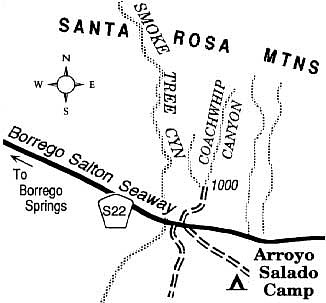 Facebook
Facebook
 X
X
 Instagram
Instagram
 TikTok
TikTok
 Youtube
Youtube
Dark thunderclouds moved into Borrego Valley on the afternoon of August 29, terrorizing residents of Borrego Springs with 70 mph gusts of wind and a downpour of one and one-half inches of rain in less than an hour. Flash floods toppled a number of power poles and cut furrows into roadways, stranding motorists. Such violent storms aren't exactly uncommon in the farthest eastern reaches of San Diego County and in Imperial County. But they do strike briefly and rather capriciously, hitting hard any given region of the desert every five or ten years.
Some of the most violent activity during the recent storm took place in the area around Arroyo Salado Campground, 16 miles east of Borrego Springs via Highway S-22 (Borrego-Salton Seaway) where boulders weighing a ton and more were deposited on the roadway by flash-flood waters.
This column hereby gives advance notice of the strong likelihood of an off-season wildflower bloom here and in the low-lying areas of Borrego Valley during the next several weeks. The purple-colored sand verbena, which carpets low-lying, sandy washes, is likely to make a significant showing starting in a week or two.
The sandy bottom, or dry wash, of Coachwhip Canyon, north of Highway S-22 and across from the entrance to Arroyo Salado Campground, may be a particularly good place to conduct your search for autumn blossoms. The wash intersects the highway at mile 34.8 (as reckoned by the green mile-markers). The wheel tracks going in may accommodate ordinary passenger cars, but turning your car around could be problematical without four-wheel drive. Appropriately nimble vehicles can make it 1.2 miles or more up either of two branches of the canyon. Off-road conditions easily change, however, and you may want to play it safe by parking on the highway shoulder and walking in.
Coachwhip Canyon also harbors a fine collection of smoke trees. This gray-green-tinted desert shrub has foliage so thin and drab that it appears vaporous at a distance. Flash floods are essential for its survival as a species. The seeds of smoke trees will not germinate unless their hard outer coating has been scoured away by the grinding action of sand suspended in flash-flood waters.
Expect that you'll see relatively few visitors out there -- it's still the off-season for tourists in the Anza-Borrego Desert. Typical daytime high temperatures will fall from near 100 degrees this month to the 80s by November. Remember to take plenty of water with you and to wear sun-protective clothing.


Dark thunderclouds moved into Borrego Valley on the afternoon of August 29, terrorizing residents of Borrego Springs with 70 mph gusts of wind and a downpour of one and one-half inches of rain in less than an hour. Flash floods toppled a number of power poles and cut furrows into roadways, stranding motorists. Such violent storms aren't exactly uncommon in the farthest eastern reaches of San Diego County and in Imperial County. But they do strike briefly and rather capriciously, hitting hard any given region of the desert every five or ten years.
Some of the most violent activity during the recent storm took place in the area around Arroyo Salado Campground, 16 miles east of Borrego Springs via Highway S-22 (Borrego-Salton Seaway) where boulders weighing a ton and more were deposited on the roadway by flash-flood waters.
This column hereby gives advance notice of the strong likelihood of an off-season wildflower bloom here and in the low-lying areas of Borrego Valley during the next several weeks. The purple-colored sand verbena, which carpets low-lying, sandy washes, is likely to make a significant showing starting in a week or two.
The sandy bottom, or dry wash, of Coachwhip Canyon, north of Highway S-22 and across from the entrance to Arroyo Salado Campground, may be a particularly good place to conduct your search for autumn blossoms. The wash intersects the highway at mile 34.8 (as reckoned by the green mile-markers). The wheel tracks going in may accommodate ordinary passenger cars, but turning your car around could be problematical without four-wheel drive. Appropriately nimble vehicles can make it 1.2 miles or more up either of two branches of the canyon. Off-road conditions easily change, however, and you may want to play it safe by parking on the highway shoulder and walking in.
Coachwhip Canyon also harbors a fine collection of smoke trees. This gray-green-tinted desert shrub has foliage so thin and drab that it appears vaporous at a distance. Flash floods are essential for its survival as a species. The seeds of smoke trees will not germinate unless their hard outer coating has been scoured away by the grinding action of sand suspended in flash-flood waters.
Expect that you'll see relatively few visitors out there -- it's still the off-season for tourists in the Anza-Borrego Desert. Typical daytime high temperatures will fall from near 100 degrees this month to the 80s by November. Remember to take plenty of water with you and to wear sun-protective clothing.
